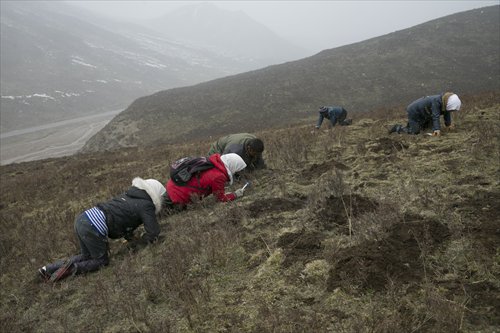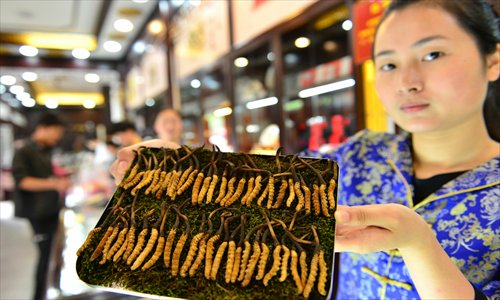Caterpillar fungus no longer worth its weight in gold

Villagers dig for caterpillar fungus on the slopes of the Qilian Mountains in Northwest China's Qinghai Province. Photo: CFP

Fresh caterpillar fungus on sale in Yiwu, East China's Zhejiang Province in May 2014 Photo: CFP
Caterpillar fungus, known in China as "worm grass," is a valuable material used in Traditional Chinese medicine that is only found in high-altitude regions, especially the Qinghai-Tibet Plateau.
Caterpillar fungus was once literally worth more than its weight in gold in China, but over the past three years, prices have fallen by half.
Dealers and experts say China's strict anti-corruption policies might be the main cause behind the decrease, which may actually be an indication that the market is regaining its natural equilibrium.
Rampant speculation
Abo, a Tibetan dealer of caterpillar fungus who lives in Lhasa, Southwest China's Tibet Autonomous Region, arrived in Beijing for the first time in July to meet with distributors and find a new market for his business.
"My dad was involved in this business as well, but he doesn't speak Putonghua (standard Chinese), so he could only trade worm grass between villages and in Lhasa," Abo told the Global Times on Monday.
"But I can speak Putonghua. I discovered on Baidu that the most valuable worm grass comes from Tibet, so I came to Beijing to try and make a deal," Abo said.
Despite its name, worm grass - literally "winter-worm summer-grass" in Chinese and Tibetan - is not really a plant. It forms when a parasitic fungus hijacks and then feeds off the bodies of ghost moth larvae that have burrowed into the soil 3,000 to 5,000 meters above sea level. The fungus then pushes the remains of the larvae bodies to the surface to spread spores, the Xinhua News Agency reported.
These mummified moths are a traditional Tibetan cure-all that is believed to help fight cancer and the aging process and boost the immune system, said Xinhua.
"Market speculation of the medical value of caterpillar fungus led to an significant increase in demand, which in turn led to an insane rise in price from the 1990s to 2013," Xiong Kunxin, an ethnic studies professor at Beijing's Minzu University of China and an expert on Tibet, told the Global Times on Tuesday.
A kilogram of caterpillar fungus in 1995 could sell for 1,000 yuan ($150), while in March 2013, this price skyrocketed to 300,000 yuan per kilogram, with high quality fungus going for as much as 1 million yuan, the Legal Weekly reported.
The bulk of the caterpillar fungus harvesting takes place from May to August each year, according to a report on scol.com.cn.
"I usually collect worm grass from villagers in rural Lhasa," Abo said.
"They just dig on the mountain slopes nearby. What they earn during the harvest season each year used to be enough to cover the expenditures of an entire family for a year."
Anti-corruption fallout
"Business isn't as good as it once was because prices have dropped to around 100,000 yuan per kilogram over the past few years," Abo said.
It's not just prices. According to the statistics from the Health Care Association of Shanghai, sales of caterpillar fungus have decreased one-third since 2013, China Food Newspaper reported in January of 2015.
According to Abo, the sale of fake caterpillar fungus has probably played a role in the drop in prices and sales, but an even bigger contributor has probably been the country's anti-corruption efforts in recent years.
"What ordinary person would buy it for themselves? It usually serves as an expensive gift," Abo explained.
Considering its high value, caterpillar fungus was a form of currency when it came to making deals for money and power.
The government's anti-corruption efforts have greatly strengthened since 2013. According to the CPC Central Commission for Discipline Inspection, discipline inspection agencies punished about 182,000 officials nationwide in 2013, a 13.3 percent increase over 2012, according to a Xinhua report.
"Actually, it's not only caterpillar fungus. Since 2013, the markets for luxury goods in China have fallen, which might also be related to increased internal regulation of the CPC," Ni Xing, a professor with the Center for Anti-Corruption Studies at Sun Yat-sen University, said.
"This is a positive trend as it shows that improper consumption and interests are being combated and the market is getting purified," Ni said.
"It's a necessary change, and as long as the anti-corruption movement continues, the price of caterpillar fungus should continue to cool down and hold at a reasonable level," Xiong said.
Even though over the short-term, anti-corruption policies have caused some fluctuations in certain industries, they will help build a healthy economic environment over the long run, Ni said.
Newspaper headline: Financial metamorphosis